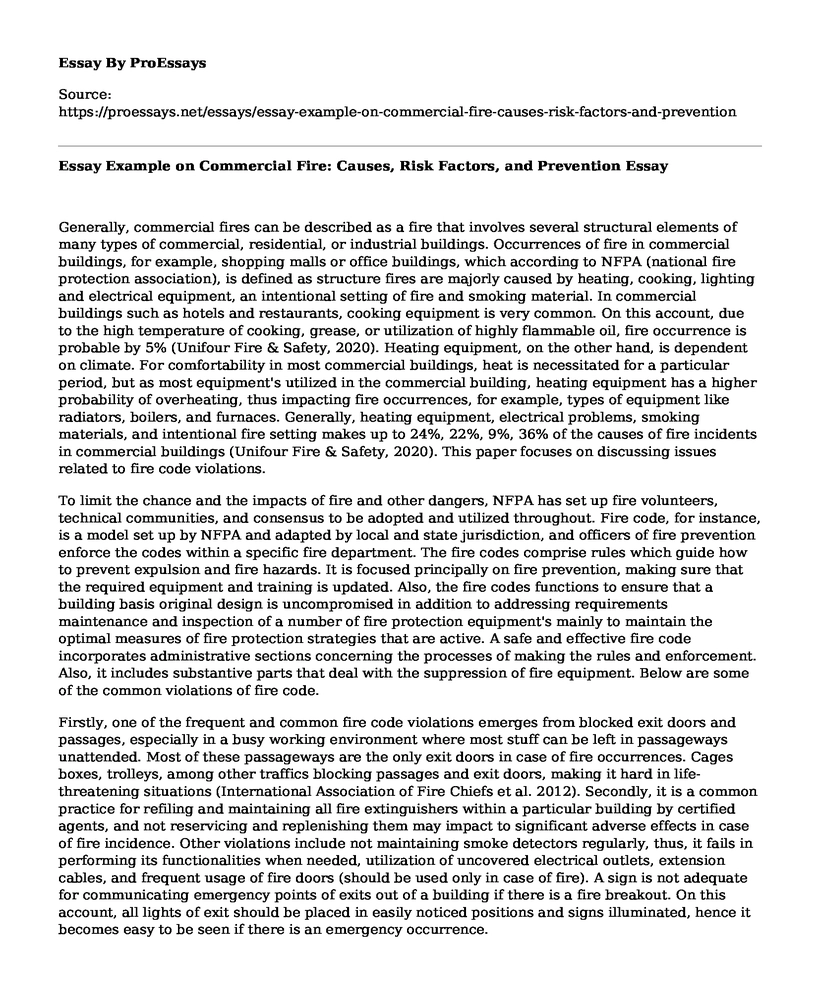Generally, commercial fires can be described as a fire that involves several structural elements of many types of commercial, residential, or industrial buildings. Occurrences of fire in commercial buildings, for example, shopping malls or office buildings, which according to NFPA (national fire protection association), is defined as structure fires are majorly caused by heating, cooking, lighting and electrical equipment, an intentional setting of fire and smoking material. In commercial buildings such as hotels and restaurants, cooking equipment is very common. On this account, due to the high temperature of cooking, grease, or utilization of highly flammable oil, fire occurrence is probable by 5% (Unifour Fire & Safety, 2020). Heating equipment, on the other hand, is dependent on climate. For comfortability in most commercial buildings, heat is necessitated for a particular period, but as most equipment's utilized in the commercial building, heating equipment has a higher probability of overheating, thus impacting fire occurrences, for example, types of equipment like radiators, boilers, and furnaces. Generally, heating equipment, electrical problems, smoking materials, and intentional fire setting makes up to 24%, 22%, 9%, 36% of the causes of fire incidents in commercial buildings (Unifour Fire & Safety, 2020). This paper focuses on discussing issues related to fire code violations.
To limit the chance and the impacts of fire and other dangers, NFPA has set up fire volunteers, technical communities, and consensus to be adopted and utilized throughout. Fire code, for instance, is a model set up by NFPA and adapted by local and state jurisdiction, and officers of fire prevention enforce the codes within a specific fire department. The fire codes comprise rules which guide how to prevent expulsion and fire hazards. It is focused principally on fire prevention, making sure that the required equipment and training is updated. Also, the fire codes functions to ensure that a building basis original design is uncompromised in addition to addressing requirements maintenance and inspection of a number of fire protection equipment's mainly to maintain the optimal measures of fire protection strategies that are active. A safe and effective fire code incorporates administrative sections concerning the processes of making the rules and enforcement. Also, it includes substantive parts that deal with the suppression of fire equipment. Below are some of the common violations of fire code.
Firstly, one of the frequent and common fire code violations emerges from blocked exit doors and passages, especially in a busy working environment where most stuff can be left in passageways unattended. Most of these passageways are the only exit doors in case of fire occurrences. Cages boxes, trolleys, among other traffics blocking passages and exit doors, making it hard in life-threatening situations (International Association of Fire Chiefs et al. 2012). Secondly, it is a common practice for refiling and maintaining all fire extinguishers within a particular building by certified agents, and not reservicing and replenishing them may impact to significant adverse effects in case of fire incidence. Other violations include not maintaining smoke detectors regularly, thus, it fails in performing its functionalities when needed, utilization of uncovered electrical outlets, extension cables, and frequent usage of fire doors (should be used only in case of fire). A sign is not adequate for communicating emergency points of exits out of a building if there is a fire breakout. On this account, all lights of exit should be placed in easily noticed positions and signs illuminated, hence it becomes easy to be seen if there is an emergency occurrence.
Conclusion
In conclusion, if most commercial buildings involved with fire occurrences could follow the fire codes strictly, most of the fire incidences could have been prevented, or at least the damages of the fire could have been minimized. Adhering to the codes of fire effectively and efficiently maintains a safe and healthy environment of work besides preventing fire damages.
References
International Association of Fire Chiefs, National Fire Protection Association, & Jones & Bartlett Learning, LLC. (2012). Fire Inspector: Principles and Practice. Burlington, MA: Jones & Bartlett Learning
Unifour Fire & Safety. (2020). Common Causes of Commercial Fires. https://www.unifourfire.com/blog/common-causes-commercial-fires
Cite this page
Essay Example on Commercial Fire: Causes, Risk Factors, and Prevention. (2023, Apr 09). Retrieved from https://proessays.net/essays/essay-example-on-commercial-fire-causes-risk-factors-and-prevention
If you are the original author of this essay and no longer wish to have it published on the ProEssays website, please click below to request its removal:
- SWOT Analysis for Hotel Example: Sheraton Hotel & Resorts
- Public Relations in the Global Environment Essay
- Operations Management Job Essay
- Sun City Public Relations Campaigns Paper Example
- Paper Example on Tariffs: A Response to Trade Deficits and Imperfect Competition
- Feed the Children Organization: Delivering Life Essentials and Hope - Essay Sample
- Essay Example on Billboards: Maximize Brand Awareness & Visibility Even in Digital Age!







